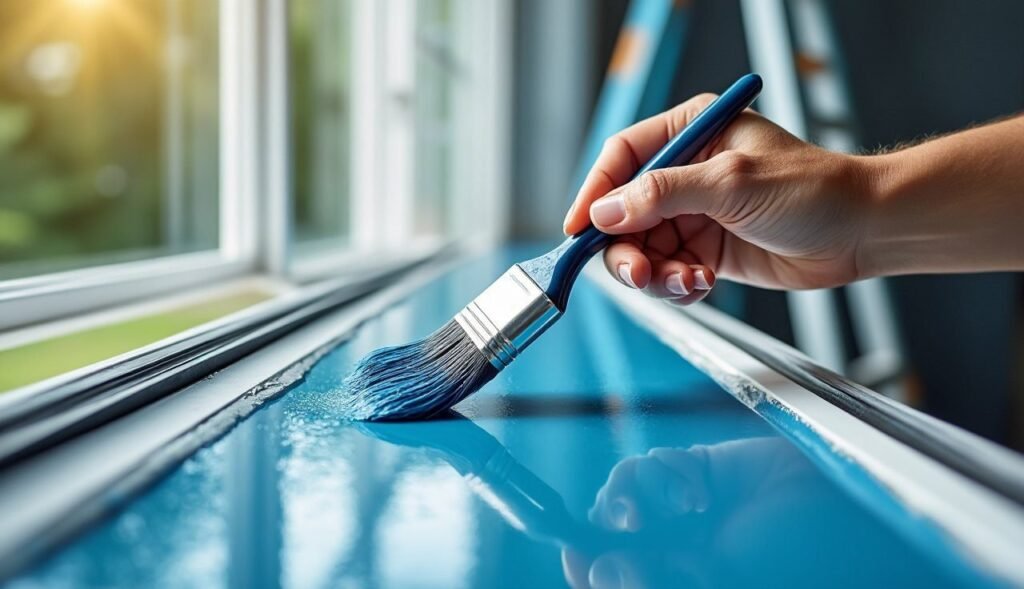
Aluminum painting isn’t just about applying a coat of paint—it starts with proper preparation. Especially in humid coastal cities like Miami, preparing aluminum surfaces before painting is crucial for ensuring durability, adhesion, and visual appeal. Whether you’re working on siding, trim, or aluminum windows, surface prep makes all the difference.
Before diving in, take a look at our essential guide to aluminum painting to get familiar with foundational techniques.
The global demand for aluminum paints continues to rise. In recent years, the market has been valued between USD 1.5 billion and USD 3.5 billion and is projected to reach up to USD 5.2 billion by 2034. With a CAGR of 5% to 6.2%, this sector underscores just how valuable quality aluminum painting has become. And Miami, with its oceanic salt air and constant sun exposure, needs special care when it comes to metal surfaces.
Painting aluminum requires a different approach than other metals due to its smooth, non-porous nature and tendency to oxidize. Without the proper preparation and techniques, paint may peel, blister, or fail to adhere altogether. Here are some key do’s and don’ts to help you achieve a professional, long-lasting finish:
Use a degreaser or trisodium phosphate (TSP) solution to remove grease, mildew, and oxidation. Dirt or oil will prevent primer and paint from bonding properly.
Lightly sand the surface or use a wire brush to create a rougher profile, allowing paint and primer to grip better.
Regular primers won’t bond well with aluminum. A self-etching primer chemically adheres to the surface, providing the foundation for lasting results.
Not all paints are compatible with aluminum. Use high-quality exterior-grade acrylic latex, oil-based, or epoxy paints designed for metal surfaces.
High humidity or extreme heat (both common in Miami) can disrupt the curing process of paint. Ideal painting conditions include temperatures between 50°F and 85°F and low humidity.
Glossy aluminum or existing flaking paint must be sanded or stripped first. Oxidation forms a chalky layer that must be removed before painting can be done.
Even the best aluminum paints will fail without the right primer underneath. Always prime first, especially if the bare metal is exposed.
Latex paint may peel from unprimed or slick aluminum. Always scuff and prime the surface beforehand.
Dry times, recoat intervals, and application methods vary between brands. Skipping these details can lead to failure or an uneven finish.
Following these do’s and don’ts ensures you’re on the right track. This guide to painting over aluminum siding provides more detailed information.

Surface prep is crucial, especially when dealing with salt exposure and humidity, which are common in Miami. Here’s a reliable five-step method:
Remove dirt, grease, chalk residue, and mildew using a trisodium phosphate (TSP) solution or a degreaser. TSP clears contaminants that hinder paint adhesion. Rinse well and let it dry thoroughly.
Use a wire brush, sandpaper (around 120–150 grit), or a sanding block to remove oxidation and old, peeling paint. Aluminum naturally oxidizes, and failure to remove it will cause the new paint to peel prematurely.
Even if the oxidation is minimal, sanding is necessary to create a profile for the primer to grip. Avoid making the surface overly smooth.
Self-etching primer is crucial. Aluminum is non-porous, so regular primers won’t bond well. Use an etching primer designed for aluminum or galvanized metals.
Humidity and temperature extremes can significantly impact drying and curing processes. Ideal conditions in Miami are early mornings or cooler days.
For a visual guide, this tutorial on preparing aluminum siding for painting is a helpful resource.
Choosing the correct type of paint can make or break the project. The right product enhances durability, resists corrosion, and retains its color beautifully, even in harsh conditions like Miami’s coastal climate. Here are the best options and why they work well on aluminum:
This water-based paint is a favorite for exterior aluminum surfaces due to its flexibility and resistance to cracking and peeling. It performs well in fluctuating temperatures, offers good UV resistance, and is easy to clean. It’s also breathable, allowing moisture vapor to escape, crucial in humid environments.
Best For: Aluminum siding, window trims, and fencing.
Watch Out: Requires proper surface prep and metal primer for best adhesion.
Known for superior adhesion and durability, oil-based paint offers excellent resistance to wear and tear, making it ideal for areas that experience regular contact or exposure. When paired with an appropriate etching primer, it forms a rigid, glossy barrier that’s less susceptible to weathering.
Best For: High-traffic aluminum doors, gutters, and shutters.
Watch Out: Longer drying time and strong fumes require well-ventilated application areas.
Epoxy-based paints are highly resistant to chemicals, moisture, and abrasion. They are two-part systems (resin + hardener) that create a rugged, industrial-grade coating ideal for demanding environments.
Best For: Aluminum panels, trim near pools, and industrial surfaces.
Watch Out: Mixing and applying can be tricky; professional application is often recommended for optimal results.
Enamel paints provide a smooth, glass-like finish that enhances the look of aluminum surfaces. They are typically oil- or solvent-based and offer strong UV resistance and gloss retention.
Best For: Decorative railings, furniture, or aluminum hardware.
Watch Out: Can chip if applied on an unprimed or greasy surface.
Spray paint offers a fast and convenient way to coat small or intricately shaped aluminum items. Look for products labeled “for metal” or “for aluminum,” as these are formulated with bonding agents and rust inhibitors.
Best For: Patio furniture, light fixtures, grills, and tools.
Watch Out: Use in low wind conditions and apply multiple light coats to avoid runs.
Still unsure? This guide on what kind of paint sticks to aluminum can help.
Older aluminum siding may have accumulated layers of chalking, oxidation, or even multiple coats of failing paint. These conditions require more extensive prep work, including deep cleaning, sanding, and possibly chemical stripping, to ensure the new coat adheres properly and looks uniform.
Miami’s coastal climate introduces salt, humidity, and intense sun exposure—all of which accelerate corrosion and fading. Choosing paints and primers that specifically address marine environments or are rated for high UV resistance is critical.
Not all primers are created equal. For aluminum siding, a self-etching or bonding primer is necessary to help the paint adhere to the non-porous surface. Skipping this step will significantly shorten the life of your paint job and may cause blistering or peeling within months.
In hot climates like South Florida, lighter paint colors aren’t just a style choice—they’re practical. Light tones reflect heat, helping to reduce thermal transfer into the home and prevent the paint from degrading under intense sun exposure. Darker colors absorb more heat and tend to fade faster.
While brushing can be effective for small areas, spraying is generally preferred for siding because it ensures an even, smooth coat across large surfaces. It also allows the paint to penetrate grooves and seams without leaving brush marks, saving time and improving finish quality.
Painting siding alone isn’t enough—elements like gutters, window frames, and trim must be addressed to ensure a cohesive and professional appearance. Make sure to use painter’s tape to protect glass and fixtures, and follow our guide to painting aluminum windows for complete coverage. Don’t forget to prep and paint trim or windows.
Pros: Easy to apply, dries fast, rust-preventative
Cons: Not ideal for large surfaces
Pros: No sanding or priming needed; bonds well to aluminum
Cons: Limited color options
Pros: Strong UV protection, mildew resistant, easy to clean
Cons: Requires primer and multiple coats
Pros: Excellent adhesion and flexibility
Cons: Can be pricier than alternatives
Pros: Professional-grade finish and fade resistance
Cons: Higher cost, longer dry time
A comprehensive overview of the best paint for aluminum surfaces offers more product comparisons.

Absolutely! When prepared correctly, it protects from oxidation and enhances aesthetics.
With proper prep and materials, up to 10–12 years. Miami’s climate may shorten that without UV-resistant paint.
Paint may blister, peel, or fail to adhere correctly. Priming is non-negotiable for longevity.
Acrylic latex, oil-based, epoxy, and enamel paints designed for metal will all work, provided an etching primer is used first.
Yes. Ensure the spray paint is rated for use on metal and apply it in multiple thin coats. Spray painting is beneficial for small-scale aluminum work.
Looking for a guide that addresses Miami Beach’s unique painting requirements? We’ve got you covered.
Preparation accounts for 80% of the aluminum painting process. The right tools, climate timing, and product choices will reward you with a long-lasting, weather-resistant finish. Don’t skip the fundamentals—they’re what separates temporary results from top-tier craftsmanship.


